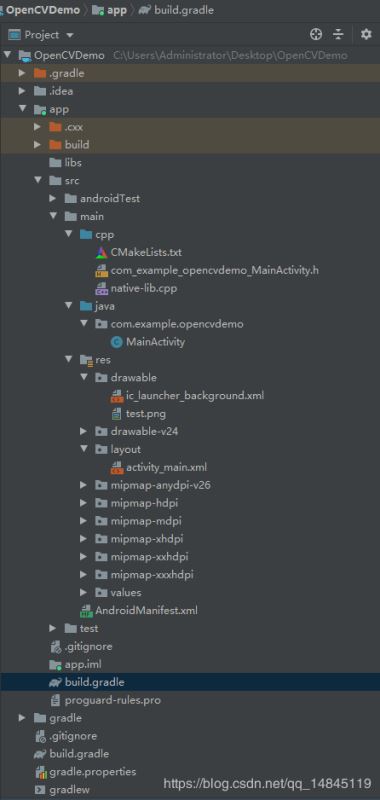android studio JNI教程opencv 基于Android studio3.6的JNI教程之opencv实例详解
watersink 人气:0基本环境:

(1)新建工程OpenCVDemo,选择,一定要选择Native c++类型,最后要选c++14支持。
(2)File->Project Structure->SDK Location,设置这3个路径,NDK选择r14b。
(3)任意找一张图片,复制到res/drawable。
(4)修改布局文件res/layout/ activity_main.xml
<?xml version="1.0" encoding="utf-8"?> <RelativeLayout xmlns:android="http://schemas.android.com/apk/res/android" android:layout_width="match_parent" android:layout_height="match_parent"> <ImageView android:id="@+id/imageView" android:layout_width="match_parent" android:layout_height="match_parent" /> <LinearLayout android:layout_width="match_parent" android:layout_height="wrap_content" android:layout_alignParentBottom="true" android:orientation="horizontal"> <Button android:id="@+id/show" android:layout_width="match_parent" android:layout_height="wrap_content" android:layout_weight="1" android:text="show" /> <Button android:id="@+id/process" android:layout_width="match_parent" android:layout_height="wrap_content" android:layout_weight="1" android:text="process" /> </LinearLayout> </RelativeLayout>
(5)修改java文件,app/src/main/java/ com.example.opencvdemo/ MainActivity
主要修改包括修改
继承OnClickListener类,
修改onCreate方法
增加c++的接口函数,getEdge
实现点击按钮的方法,
整体代码如下,
(6)Termi
package com.example.opencvdemo;
import androidx.appcompat.app.AppCompatActivity;
import android.graphics.Bitmap;
import android.graphics.BitmapFactory;
import android.os.Bundle;
import android.view.View;
import android.widget.ImageView;
import android.widget.TextView;
public class MainActivity extends AppCompatActivity implements View.OnClickListener{
// Used to load the 'native-lib' library on application startup.
static {
System.loadLibrary("native-lib");
}
@Override
protected void onCreate(Bundle savedInstanceState) {
super.onCreate(savedInstanceState);
setContentView(R.layout.activity_main);
imageView = findViewById(R.id.imageView);
findViewById(R.id.show).setOnClickListener(this);
findViewById(R.id.process).setOnClickListener(this);
}
/**
* A native method that is implemented by the 'native-lib' native library,
* which is packaged with this application.
*/
//获得Canny边缘
public native void getEdge(Object bitmap);
private ImageView imageView;
@Override
public void onClick(View v) {
if (v.getId() == R.id.show) {
Bitmap bitmap = BitmapFactory.decodeResource(getResources(), R.drawable.test);
imageView.setImageBitmap(bitmap);
} else {
Bitmap bitmap = BitmapFactory.decodeResource(getResources(), R.drawable.test);
getEdge(bitmap);
imageView.setImageBitmap(bitmap);
}
}
}
nal下进入app\src\main\java这一层目录,执行,
javah com.example.opencvdemo.MainActivity
将生成的com_example_opencvdemo_MainActivity.h,剪切到app/src/main/cpp目录下。
(7)修改app/src/main/cpp下面的native-lib.cpp,主要通过c++实现getEdge方法,主要代码如下,
#include <jni.h>
#include <string>
#include "com_example_opencvdemo_MainActivity.h"
#include <android/bitmap.h>
#include <opencv2/opencv.hpp>
using namespace cv;
extern "C"
JNIEXPORT void JNICALL
Java_com_example_opencvdemo_MainActivity_getEdge(JNIEnv *env, jobject obj, jobject bitmap){
// TODO: implement getEdge()
AndroidBitmapInfo info;
void *pixels;
CV_Assert(AndroidBitmap_getInfo(env, bitmap, &info) >= 0);
CV_Assert(info.format == ANDROID_BITMAP_FORMAT_RGBA_8888 ||
info.format == ANDROID_BITMAP_FORMAT_RGB_565);
CV_Assert(AndroidBitmap_lockPixels(env, bitmap, &pixels) >= 0);
CV_Assert(pixels);
if (info.format == ANDROID_BITMAP_FORMAT_RGBA_8888) {
Mat temp(info.height, info.width, CV_8UC4, pixels);
Mat gray;
cvtColor(temp, gray, COLOR_RGBA2GRAY);
Canny(gray, gray, 125, 225);
cvtColor(gray, temp, COLOR_GRAY2RGBA);
} else {
Mat temp(info.height, info.width, CV_8UC2, pixels);
Mat gray;
cvtColor(temp, gray, COLOR_RGB2GRAY);
Canny(gray, gray, 125, 225);
cvtColor(gray, temp, COLOR_GRAY2RGB);
}
AndroidBitmap_unlockPixels(env, bitmap);
}
(8)修改CMakeLists.txt
包括增加opencv包含路径,增加opencv链接,增加目标库的链接(OpenCV_LIBS和jnigraphics)
全部代码如下,
# For more information about using CMake with Android Studio, read the
# documentation: https://d.android.com/studio/projects/add-native-code.html
# Sets the minimum version of CMake required to build the native library.
cmake_minimum_required(VERSION 3.4.1)
# Creates and names a library, sets it as either STATIC
# or SHARED, and provides the relative paths to its source code.
# You can define multiple libraries, and CMake builds them for you.
# Gradle automatically packages shared libraries with your APK.
#设置OpenCV-android-sdk路径
set( OpenCV_DIR E:/Android/OpenCV-android-sdk/sdk/native/jni )
find_package(OpenCV REQUIRED )
if(OpenCV_FOUND)
include_directories(${OpenCV_INCLUDE_DIRS})
message(STATUS "OpenCV library status:")
message(STATUS " version: ${OpenCV_VERSION}")
message(STATUS " libraries: ${OpenCV_LIBS}")
message(STATUS " include path: ${OpenCV_INCLUDE_DIRS}")
else(OpenCV_FOUND)
message(FATAL_ERROR "OpenCV library not found")
endif(OpenCV_FOUND)
set(CMAKE_SHARED_LINKER_FLAGS "${CMAKE_SHARED_LINKER_FLAGS} -Wl,--exclude-libs,libippicv.a -Wl,--exclude-libs,libippiw.a")
add_library( # Sets the name of the library.
native-lib
# Sets the library as a shared library.
SHARED
# Provides a relative path to your source file(s).
native-lib.cpp )
# Searches for a specified prebuilt library and stores the path as a
# variable. Because CMake includes system libraries in the search path by
# default, you only need to specify the name of the public NDK library
# you want to add. CMake verifies that the library exists before
# completing its build.
find_library( # Sets the name of the path variable.
log-lib
# Specifies the name of the NDK library that
# you want CMake to locate.
log )
# Specifies libraries CMake should link to your target library. You
# can link multiple libraries, such as libraries you define in this
# build script, prebuilt third-party libraries, or system libraries.
target_link_libraries( # Specifies the target library.
native-lib
${OpenCV_LIBS}
jnigraphics
# Links the target library to the log library
# included in the NDK.
${log-lib} )
(9)修改app/build.gradle
主要增加cmake的cppFlags,arguments
全部代码如下,
apply plugin: 'com.android.application'
android {
compileSdkVersion 29
buildToolsVersion "29.0.3"
defaultConfig {
applicationId "com.example.opencvdemo"
minSdkVersion 16
targetSdkVersion 29
versionCode 1
versionName "1.0"
testInstrumentationRunner "androidx.test.runner.AndroidJUnitRunner"
externalNativeBuild {
cmake {
cppFlags "-std=c++14 -frtti -fexceptions"
arguments '-DANDROID_STL=gnustl_shared' //支持C++异常处理标准模板快,ndk16+需要注释
//abiFilters "armeabi-v7a", "arm64-v8a", "x86_64"
}
}
}
buildTypes {
release {
minifyEnabled false
proguardFiles getDefaultProguardFile('proguard-android-optimize.txt'), 'proguard-rules.pro'
}
}
externalNativeBuild {
cmake {
path "src/main/cpp/CMakeLists.txt"
version "3.10.2"
}
}
}
dependencies {
implementation fileTree(dir: 'libs', include: ['*.jar'])
implementation 'androidx.appcompat:appcompat:1.1.0'
implementation 'androidx.constraintlayout:constraintlayout:1.1.3'
testImplementation 'junit:junit:4.12'
androidTestImplementation 'androidx.test.ext:junit:1.1.1'
androidTestImplementation 'androidx.test.espresso:espresso-core:3.2.0'
}
(10)整体目录结构如下,

运行程序,

代码链接:
References:
https://www.jianshu.com/p/6e16c0429044
https://www.bilibili.com/video/av55834524/
总结
加载全部内容